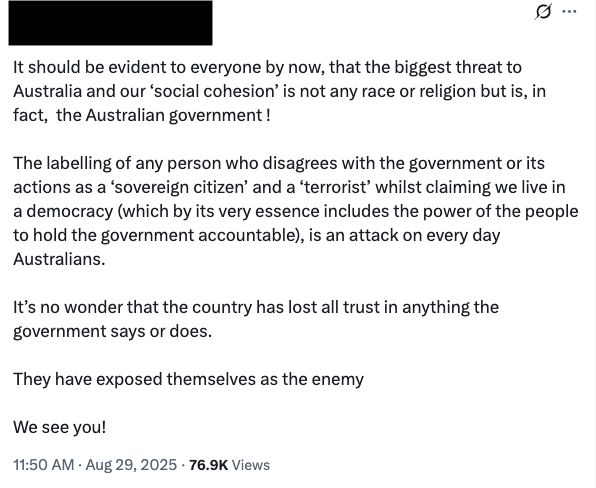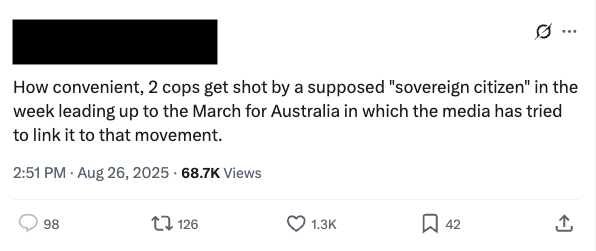Sovereign Citizen Case Study
Remit
The remit of this case study demonstrates how social listening can provide in-depth, unsolicited data related to a fringe movement within Australian society. These insights can be leveraged by institutions or organisations interested in strengthening social cohesion and understanding the broader implications of similar movements.
Topic
In terms of scope, the case study examines insights focusing on both broad conversations related to the sovereign citizen movement across open-source domains and conversations within proclaimed sovereign citizen groups that take place across publicly available platforms.
Purpose
This case study was conducted to achieve two key outcomes:
Illustrate, using the Porepunkah incident on the 26th of August 2025 as an example, how social listening can improve an organisation’s understanding of public perception, dominant narratives and themes following an event or crisis.
Highlight, through a focus on the sovereign citizen movement, how social listening can uncover crucial insights into group intent and capability to supplement policing operations.
Background
Largely unknown in Australia prior to the COVID-19 Pandemic, the Sovereign Citizen Movement has propelled itself into public awareness following the harrowing 2025 attack on three police officers in Victoria by an adherent of the ideology. Though best described as a loose, decentralised grouping of communities underscored by anti-government sentiment, the Sovereign Citizen movement over the last half-decade has seen an increase in movement cohesion and recruitment. These groups advocate for the rejection of government laws, do not recognise government authority, and have been known to advocate for violence in resistance to perceived tyranny.
The Challenge
Intelligence organisations, particularly in the Open-Source Intelligence (OSINT) domain, are being outpaced by the rapid growth of publicly available information. The sheer volume and speed of this data render it impossible to monitor effectively through manual methods alone.
Without effective tools to manage public data, agencies face the risk of actionable data being lost among noise, ultimately hindering the capacity to detect, plan and respond to emerging threats.
On a more isolated scale, managing social cohesion in relation to the sovereign citizen movement hosts its own set of challenges. Unlike other contemporary movements, such as those seen on the far ends of the political spectrum, which typically rally around a clear ideology, the greater sovereign citizen movement lacks a centralised structure or leadership. Leveraging social media intelligence is crucial to bridge potential intelligence gaps, permit informed policing, and enhance law enforcement understanding and situational awareness.
Understanding the evolution of this ideology and its key characteristics is, therefore, a necessity for agencies seeking to establish a robust early warning system, highlight potential flashpoints, and enable effective subsequent operations. This movement’s presence on mainstream social media platforms for intra and intergroup communication and coordination makes social listening technology an irreplaceable resource for extracting the relevant insights required to understand, plan and respond to emerging sovereign citizen threats.
The Application of OSINT
This case study leveraged social listening to collect publicly and legally accessible data across open sources. This included the analysis of social media platforms such as Facebook and X, collecting exclusively unsolicited and unstructured discourse between the 25th of August and the 11th of September 2025. Data was segmented between environments targeting both general sovereign citizen affiliated discourse as well as event or individual-centric queries, accounting for a total of approximately 50,000 messages. In addition to thematic clustering and sentiment tracking, data was further decanted via separation into condemnatory and supportive language to effectively identify patterns of public perceptions throughout the data collection period.
Understanding Discourse Narratives
Analysis of the collected data revealed the emergence of several key themes following a sharp increase in sovereign-citizen relevant discourse following the events of the 26th of August 2025. Discussion volume peaked the following day and subsided to pre-event levels after two weeks.
A graph demonstrating the volume of discussions online related to the sovereign citizen movement between late August and Mid-September. Note the spike following the 26th of August incident.
While the majority of conversations at 37,400 messages referenced the event specifically, general discourse surrounding the movement was also promoted, spanning some 9800 discussions. Analysis of topics demonstrated discussion focused on key individuals related to the incident, as well as sub-elements of the broader sovereign citizen movement, such as their belief in the Magna Carta.
Dominant themes identified over the data collection period.
Among the most prominent themes included:
Criticism of the Australian government and perceived draconian behaviour.
The most reposted and liked X post of the 29th of August accused the Australian government of attacking citizens who disagree with government action, applying labels such as ‘sovereign citizen’ to erode the legitimacy of outspoken individuals.
Scepticism of sovereign citizen involvement.
One 26th August post, reposted 126 times and receiving 1,300 likes, appeared to doubt the authenticity of links between the shooting and the sovereign citizen movement. This post implied that wider government had been seeking avenues to delegitimise the upcoming 31st of August rally as a ‘sovereign citizen activity’ and that their branding of the alleged perpetrator as a sovereign citizen was intended to advance this agenda.
Disagreement over ‘Sovereign Citizen’ label.
One popular post, which received significant retweets, reprimanded mainstream media’s application of the ‘sovereign citizen’ term, stating that the movement ‘does not exist’ and such labels are giving credibility to rogue individuals.
Additional, smaller scale themes were also present which included condemnation aimed at the movement more broadly, as well as discussion surrounding gun rights.
Community Centric Insights
The collection and synthesis of discussions localised to groups and individuals linked to the movement provides the following opportunities:
A. Early Warning
Tracking rhetoric spread, content, and trends allows agencies to ascertain risk and anticipate shifts to violent action before they occur. Keyword and theme clustering can also reveal radicalisation hotspots and key flashpoints, allowing for agencies to establish tailored and resonant community engagement initiatives, counter-messaging strategies and increased conventional policing efforts where necessary. KINSHIP Digital leveraged keyword-based searches to capture and map rhetoric insights present among online sovereign citizen communities and broader social media.
Social listening data displaying the presence of language of condemnation and support for the shooter across social media.
A post identified on a sovereign citizen website surfaced through social listening. Themes of war and resistance are commonplace within community discussion and ideology.
B. Networking Identification
While some adherents to the sovereign citizens ideology may seek out closed, controlled communities to avoid external scrutiny, several public online and offline groups remain active. Investigations into public networks can provide crucial information regarding demographic composition, group size and capability, and key individuals who may be at risk of legal noncompliance or amplify violent rhetoric. An understanding of the group’s language and beliefs informed the likely self-designations they would employ online. Applying these identifiers to Facebook searches enabled the discovery of multiple groups associated with the same movement.
A post from one group with overtones reminiscent of the sovereign citizen movement.
Deeper investigation also linked these groups to individuals connected to ‘pseudolaw’ belief systems which were frequently cited within these movements.
Monitoring Kinetic Activity
Social listening can map key tactical data relating to more centralised sovereign citizen groups, including the identification of intentions to engage in kinetic action, such as protests, recruitment drives and fundraising efforts. This has the added benefit of providing unsolicited data related to public perceptions and support for these groups and can contribute to the establishment of evidence-backed risk frameworks for future engagements.
Events located on a sovereign citizen movement group page.
Though the post is related to a protest that is not exclusive to the sovereign citizen movement, social listening analysis provides the opportunity to understand group intent.
Conclusion
The sovereign citizen movement in Australia presents a complex task for agencies. Its decentralised nature and reliance on digital spaces to coordinate activity and bolster membership necessitate a capability to quickly and effectively turn online data into actionable insights.
The observations drawn from this analysis provide valuable insights into implications for both government and law enforcement agencies. Online narratives surrounding the sovereign citizen can be leveraged as indicators of the prevalence and impact of fringe ideologies on mainstream discourse and its subsequent impact on social cohesion. Identifying these themes in real time provides agencies with the ability to anticipate shifts in community sentiment, identify when rhetoric is escalating toward violence, and understand how such incidents are framed and perceived in dominant public sentiment. Online conversations, therefore, serve as an indicator of risks to public safety and cohesion.
Individuals tasked with maintaining security and social stability can apply these insights, permitting the detection of narratives as they emerge. This includes data retrieval to inform strategic messaging aimed at countering misinformation, identifying key threats to social cohesion and enabling more tailored crisis response strategies. Social listening offers a continuous, unsolicited data stream that ensures remit holders are not only responding to crises more effectively but actively managing the information environment where these crises develop.













